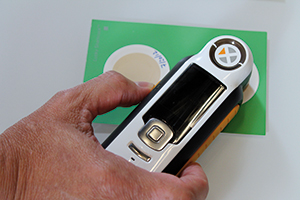
| OELCHECK test instrument: | X-Rite RM200QC |
| Sample quantity: | 50 ml |
| Unit: | none (index) |
| Test result: | MPC (Membrane Patch Colorimetry) index, luminance L, red value a, yellow value b |
| Analysis for: | Oils from gas and steam turbines, circulation systems, hydraulic systems |
| Brief description: | Before the analysis, the sample is shaken by hand for 30 s after a break of minimum 5 hours. Afterwards 50 ml sample and 50 ml filtered heptane are slowly mixed together. The oil solvent mixture is filtered under a vacuum (710 mbar) through a dried membrane, pore size 0,45 µm. When all visible liquid is gone, the membrane is dried for 3 hours at 80 °C. The color of the residues on the patch is analyzed with the colorimeter. A light source which consists of three LEDs emits light within the spectral region onto the membrane. The residues on the membrane reflect or absorb the light completely or partly. A sensor detects the intensity of the reflected light at different light wave spectra. The electronics analyses the difference between the sent and the reflected light. The differences in reflection and the color intensity at the different spectral regions make the calculation of the MPC index possible. |
| Statement: | The value of the MPC index correlates to the potential of the oil to form residues or varnish. The higher the MPC index, the more intense the filter’s color change is. Then, the oil contains a lot of soft particles, which often have a high molecular weight. They conglomerate with each other and form deposits easily on all oiled surfaces because of their high polarity. They can block valves and handicap the oil-based control of the turbine. Varnish on bearing-seats of friction-type bearings change the geometry of the bearing and influence the load carrying capacity of the bearing. Typical indications for varnish are e.g. decreasing service life of filters, or residues at the tank wall. |
| Underlying test standard: | ASTM D7843 |